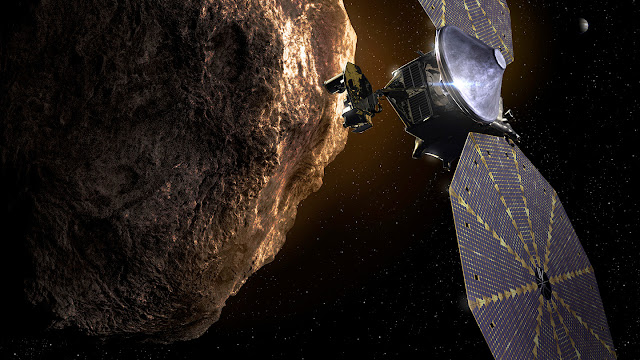Lucy: NASA's mission to the Trojan Asteroids (Pre-Flyby)
 |
| Illustration of Lucy at a Trojan. Credit: NASA |
Build your own Lucy spacecraft out of LEGO here.
Make a paper model of the Lucy spacecraft here.
Lucy is NASA's ongoing mission to study the Trojan asteroids. Lucy's mission proposal originally planned to visit 7 asteroids, but the number has risen since then. Lucy will be able to visit so many different asteroids, thanks to a complex orbital trajectory, and multiple gravity assists.
 |
| Lucy mission path from Jupiter's point of view. Credit: Southwest Research Institute |
The Mission So Far
Lucy is named after the famous Lucy skeleton. This skeleton was of the ancient human ancestor Australopithecus afarensis, and was one of the most complete skeletons of its kind. This skeleton got its name from the Beatles song "Lucy in the Sky with Diamonds," which was playing during the dig for the skeleton. Lucy launched on an Atlas V rocket in October of 2021. Shortly after, the spacecraft suffered a malfunction of its solar arrays. Lucy's solar panels unfold like a paper fan, but one of the panels failed to latch properly. Fortunately this isn't life threatening for the mission, and Lucy should be just fine.
 |
| Launch of Lucy. Credit: NASA/Kim Shiflett |
Lucy made a gravitational assist of Earth in October of last year, and that put the spacecraft on an orbit that goes past Mars. After its flyby of Dinkinesh, Lucy's newest target, the spacecraft will make another gravity assist of Earth. This will put Lucy on a trajectory to Donaldjohanson, a main-belt asteroid named after the Lucy fossil's discoverer.
Lucy will then head out to the L4 Trojans ahead of Jupiter, which includes four targets, in 2027. In 2031, Lucy will perform another Earth gravity assist to boost it to the L5 trojans. Lucy will get there in 2033, completing its primary mission. However, it is possible that the spacecraft could live on to commit another flyby, if its in good condition, and a target can be found crossing its orbital path.
The Targets
Lucy's main mission is to learn about the Trojan asteroids, which orbit in gravitationaly stable points infront of, and behind, Jupiter. Several other asteroids have been added to the selection, with a total of 10 targets at the time of writing. Lucy will first fly by Dinkinesh on November 1 this year. Then it will visit Donaldjohanson on April 20, 2025. In 2027 Lucy will visit the L4 Trojans. Eurybates and its moon Queta, on August 12, 2027. Polymele and its currently unnamed moon on September 15, 2027. Leucus on April 28, 2028. And Orus on November 11, 2028.
After Lucy's third Earth gravity assist, it will visit the L5 Trojans in 2033. Lucy will fly by the binary system Patroclus and Menoetius on March 2, 2033. Currently these are the only planned targets in the L5 Trojan swarm, but more could be added in the future.
Resources on the Lucy mission can be found here.
 |
| Lucy's original 7 Targets. Credit: NASA/Goddard Space Flight Center Conceptual Image Lab |
 |
| Lucy's current best views of its L4 Trojan targets. Credit: NASA/Goddard/SwRI/JHU-APL |
 |
| Dinkinesh compared with Steins and Bennu. Credit: NASA/Goddard/University of Arizona/ESA |


Comments
Post a Comment